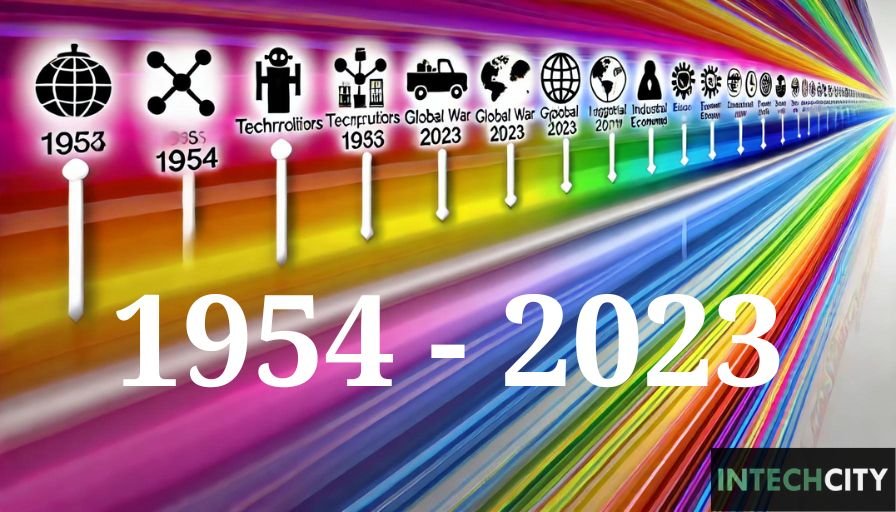The timeframe from 1954 to 2023 encompasses nearly seven decades of profound changes and significant events that have shaped our modern world. This period witnessed remarkable advancements in technology, shifts in cultural and social norms, and notable political and economic transformations. This article explores the key events and trends that defined this era, providing insights into how the past has influenced the present and what lessons can be drawn for the future.
Technological Advancements
1954: The Dawn of Modern Technology
In 1954, technological innovation was beginning to gain momentum:
- First Kidney Transplant: Performed by Dr. Joseph Murray, marking a milestone in medical history.
- Introduction of Transistors: Revolutionized electronics by replacing bulky vacuum tubes, paving the way for smaller, more efficient devices.
- Television and Radio: Became the primary sources of entertainment and information, with families gathering around to watch popular shows and news broadcasts.
2023: A Digital Revolution
By 2023, technology had transformed nearly every aspect of life:
- Artificial Intelligence (AI): AI and machine learning became integral in various fields, from healthcare to finance.
- Virtual Reality (VR): Expanded into education, gaming, and professional training, providing immersive experiences.
- Smart Devices: The proliferation of smartphones, smart homes, and the Internet of Things (IoT) interconnected the world like never before.
Cultural Shifts
Cultural Landscape in 1954
The mid-20th century was characterized by:
- Music and Entertainment: Icons like Elvis Presley and Ella Fitzgerald dominated the music scene, influencing future generations.
- Social Norms: Gender roles were more rigid, with traditional expectations for men and women.
- Civil Rights Movement: Began to gain traction, leading to significant social and legal changes in subsequent decades.
Cultural Evolution by 2023
By 2023, culture had evolved significantly:
- Diverse Representation: Increased visibility and inclusion of various ethnicities, genders, and LGBTQ+ communities in media and entertainment.
- Globalization: Cultural exchange and globalization led to a blend of traditions and modern influences worldwide.
- Social Media: Platforms like Instagram, Twitter, and TikTok became powerful tools for cultural expression and social movements.
Political and Economic Transformations

Political Climate in 1954
The political landscape in 1954 was marked by:
- Cold War Tensions: The rivalry between the United States and the Soviet Union influenced global politics and led to the arms race.
- Decolonization: Many countries in Africa and Asia were gaining independence from colonial powers.
Political Dynamics in 2023
By 2023, the political scene had shifted dramatically:
- Global Cooperation: Increased efforts in international cooperation to tackle issues like climate change and global health.
- Technological Governance: Issues of data privacy, cybersecurity, and AI ethics became central to political discourse.
- Populism and Nationalism: Resurgence in some regions, impacting global trade and diplomatic relations.
Economic Developments
Economy in 1954
Post-World War II, the economy was characterized by:
- Industrial Growth: Rapid industrialization and economic growth in Western countries.
- Consumerism: Rise of consumer culture with increased availability of goods and services.
Economy in 2023
By 2023, the global economy had undergone significant changes:
- Digital Economy: Dominance of tech giants and digital platforms in the global market.
- Sustainability: Shift towards sustainable practices and renewable energy sources.
- Economic Disparities: Ongoing challenges with income inequality and economic disparity between regions.
Conclusion
The period from 1954 to 2023 highlights the dynamic nature of human progress. Technological advancements, cultural shifts, and political and economic transformations during these decades have significantly shaped the contemporary world. Reflecting on these changes provides valuable insights into our past and helps us navigate the future with a deeper understanding of our history and its enduring impact on society.
By examining the developments between 1954 and 2023, we can appreciate the progress made and recognize the challenges that remain. This historical perspective enables us to learn from past experiences and aspire to build a more inclusive, innovative, and sustainable future.


